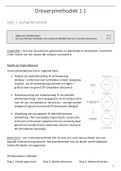Global Development and Prosperity
HC1 Economic growth and mainstream development perspectives
- GDP: Gross Domestic Product
➢ The monetary value of production and consumption of a country over the course of a year
➢ ‘Real’ GDP: corrected by inflation
➢ To compare across countries, correct for PPP
➢ Based on financial transactions in markets, money spent
➢ nichenets: GDP is size of economy not indicator welfare nor
precise measure
- What is economic growth? Rate: % increase of GDP per year
➢ 3.5% growth means 20 years doubling
➢ Compound/ exponential growth
➢ Global GDP and GDP per capita have grown exponentially
- Production through combining capitals: the combination of
different factors of production such as capital, labour, technology,
produce real GDP-> efficient use of scarce resources
➢ You can achieve growth through the increase of these capitals
and improving efficiency (investments, innovation, R&D,
more people, search for capital)
- How do we measure GDP
➢ By income: wages+ profits+ ‘Mixed income’ + Taxes- Subsidies
➢ By outputs/ gross value added: sales- costs of inputs (intermediate use) + taxes – subsidies
➢ By expenditure on all goods and services: consumption+ investment+ government purchases+ (exports-
imports)
Statisticians collect data using surveys: accuracy? Globalization and online markets? Crypto
currencies?
International standard: system of national accounts (IMF, OECD, UN, WB)-> use same measure,
needs to be constantly updated
- GDP critique:
➢ Stiglitz, Sen, Fitoussi-> the process is wrong, the measure is wrong, the data/statistics are wrong, the
interpretations and use of the results are wrong
- What is (not) included in GDP?
➢ Medical services, warheads, arms, tobacco, timber, oil, cleaning up oil spill= included
➢ Illness, loss of lives, destruction of nature, air pollution, climate change, loss of marine biodiversity= not
included
➢ Voluntary/unpaid work, leisure time= not included
➔ Environmental economist try to internalize these omitted impacts
- Sarkozy report
➢ Measure of the size of the economy
➢ Not an indicator of human or planetary wellbeing
GDP per capita is an average, but provides no information about income per household (disposable
income) or wealth
Excludes non-material well-being: length, quality of life, health, education, governance/political
voice, social relationships, safety/ security
Excludes negative impact on future well-being & environment: depreciation of capital/ wealth
GDP does not measure inequality
- Why do we still use it?
➢ Single figure
➢ Associated with major improvements in poverty reduction, life expectancy (Sachs MOOC)
➢ Became popular during WOII, now highly institutionalized
➢ Political objective (growth by about 2-3% per year…)
Central to macro-economic policies
‘more jobs, more profit, more income’
Attract investors, for more …
- Global Development policy
➢ International aid
➢ Economic growth stimulus:
Stimulate international, free trade
Economic sector development: agricultural revolution, industrialisation, privatisation to improve
efficiency
, Assumption: aid boosts economic growth
- Is continuous growth possible? Yes-camp
➢ Innovation (efficiency)
➢ Decoupling: as an economy growth in size, they pollute more with growth in beginning but because more
wealthy can invest in cleaner energy and thus less pollution long run -> mixed evidence
- No-camp
➢ Limits to growth (ecological economics): finite resources and sinks
Thermodynamic: matter and energy cannot be created or destroyed: non-renewables, overharvesting
Entropy: material and energy degrade over time; waste, not 100% recycling -> 38% of inputs are
being recycled of paper: collection, contamination-> 73% max recyclable
- Is continuous growth desirable:
➢ Is it morally acceptable for humans to appropriate all natural resources?
➢ Material growth may be condition for flourishing (?) but, beyond certain income level, happiness no
longer increases
➢ Inequality
- Economic development
➢ Not about getting bigger, but about getting better
➢ Happy lives, healthy ecosystems, vibrant communities, meaningful jobs (not bullshit jobs)
➢ So what is prosperity? And what is development? And how can we achieve that?
- Alternatives: development and prosperity
➢ Paradigms: steady state economy, degrowth, circular economy, green economy etc.
➢ Measure: genuine progress indicator, capital, quality of life, subjective well-being, HDI, multidimensional
poverty index, ecological footprint, happy planet index, gross national happiness etc.
- Economic growth is still used as a headline figure in politics etc.
➢ The creators recommended not to use it as a wellbeing metric
➢ It excludes many impacts of economic activity, including environmental ones
➢ It indicates something else than economic development
- Growth is associated with rapid increases in various well-being indicators in many low-income countries
- Economic growth possible or desirable? Yes or no? how does your grand challenge contribute to growth,
which aspects not included in GDP are relevant?
Report by the Commission on the Measurement of Economic Performance and Social Progress, H1 Classical
GDP Issues
- GDP is market production but used as well-being measure-> misleading and wrong policy decisions
- Monetary valuation makes it easy to add up quantities of a very different nature-> appreciation-> GDP
captures all final goods -> living standards
- Issues: some goods and services are hard to value, also quality change hard to measure (underestimate real
income)-> under estimating inflation in Europe due to peoples perception and over-adjusting
- Market prices not always good carriers of correct economic signals -> temporal and spatial-> not useful for
aggregation of quantities
- Five ways of dealing with this:
➢ First, emphasize well-established indicators other than GDP in the national accounts.
➢ Second, improve the empirical measurement of key production activities, in particular the provision of
health and education services.
➢ Third, bring out the household perspective, which is most pertinent for considerations of living standards.
➢ Fourth, add information about the distribution of income, consumption and wealth to data on the average
evolution of these elements.
➢ Finally, widen the scope of what is being measured. In particular, a significant part of economic activity
takes place outside markets and is often not reflected in established national accounts
- Imputations (replacing missing data):
➢ Comprehensiveness: better compare over time and between places
➢ Invariance principle: value of main accounting aggregates should not depend on institutional
arrangements in an country
- Data quality goes down with imputations-> but more comprehensibility
- National accounts aggregates: net rather than gross-> depreciation hard to estimate thus gross -> but current
technology causing NDP to increase less than GDP
- Not taken into account degradation of natural environment -> natural resource depletion: excluding value of
natural resources or take depletion into account with depreciation measures
- Globalization causes difference income and production-> net national disposable income (sent abroad)
- Prices import evolve differently from exports-> have to take into account in living standards
- Need more effort to come to grips with tracking the quantity and quality of services in modern economies
, - Governments provide two types of services: ‘collective’ and ‘individual’-> some also provided by private
sector-> if there is positive productivity growth in public sector our measures under-estimate growth -> hard
to capture quality change
- Reliability of output-based measures: based on observations detailed enough to avoid mixing up true volume
changes with compositional effects -> improve volume measures of output and improve volume measure
input
- Expenditures required to maintain consumption levels or functioning of society are intermediate input-> hard
to identify which: focus on household consumption, widen asset boundary, widen household production
boundary-> biggest obstacle in implementation
- Wealth important sustainability actual consumption-> also for economy-> investments minus depreciation and
depletion -> often incomplete, certain assets not recognized (valuing stocks is hard because some have no
markets)-> assets and liabilities key for assessing economy
- Household income by adding and subtracting transfer payments-> disposable income: neglects in-kind
services
- Adjusted disposable income is national accounts measure that goes some way towards accommodating
invariance principle at least social transfers in kind by government-> biases of cost of producing these
services is the price (may exceed value to household: distributional aspect) and value of insurance
- Not just average but also median ‘typical’ individual-> inequality-> distribution income versus distribution
consumption -> for median need micro-economic information: macro also includes all in prison etc and micro
doesn’t-> measurement: macro totals for whole country, micro just a household-> adjustments because
household size shrinks -> discrepancy macro and micro: property income, top incomes underrepresented in
micro survey and comparability far from perfect -> need average income with distributional element -> but
also correct for price
- Shift public to private and production from household to market shouldn’t impact measure yet they do->
different living standards -> market based is biased picture
- Household production is housework etc.-> allocation specific activities to time-use categories as well as their
international comparison leaves room for improvement and harmonization -> value of labour is the cost so for
instance time spend etc.-> lack estimates for productivity changes -> do give magnitude -> also leisure affects
wellbeing need not be biased towards -> orders of magnitude-> broader measures of economic activity and
leisure makes a difference in time and space
- Income levels compared in real terms: PPP-> ‘full’ income-> real income per capita-> need to add in
government services and housework and leisure
- Distributional measure difficult to develop: various groups income flows imputed at macro level when
comprehensive measures of income were derived -> yet necessary
- Main recommendations:
➢ Look at income and consumption rather than production
➢ Consider income and consumption jointly with wealth: assets and liabilities
➢ Emphasise the household perspective.
➢ Give more prominence to the distribution of income, consumption and wealth.
➢ Broaden income measures to non-market activities.
HC 2 The Sachs Easterly debate on international aid
- RCTs if development programs are effective
- What is ‘development? Whose ideology?
➢ From 1940s economic growth -> development
through industrialization
➢ 1950s change in politics-> modernize politics and
society -> make people more rational
➢ 1970s development should not only focus on
economic growth but freedom to achieve what
they want to achieve-> to choose freely their
future-> Amartya Sen
➢ 1980s: Brundtland report to check development
➢ 1980s rise of neoliberalism: economic growth-> capitalism-> free market-> detach from government
➢ 1990s post-development movement-> reflected on policies out there and if they were doing anything good
or new way of controlling developing societies
➢ 2000s Structural reforms in countries that didn’t develop as much as western countries-> MDGs-> SDGs
- Development as a concept:
➢ Long term process of structural and societal transformation (broad way of thinking)-> short to medium
term outcome of desirable targets (SDGs)-> dominant ‘discourse’ of western modernity-> no consensus
what it means and to be achieved
, - Developments in development-> left more neoliberal and right side more social paradigm
➢ Structuralism (government primary agent, free market) vs. institutional, agency- oriented (actors,
participation)
➢ Materialist, reductionist (income, money) vs. multidimensional, holistic
➢ Top-down, macro, generalized vs. bottom-up, localized, diversity
➢ Eurocentrism vs. decolonization, culture, ILK
- Global development policy
➢ Washington consensus- 1989-> World Bank and IMF
➢ Core ideology: neoliberalism, free markets
Switch of power from state to market
➢ Economic growth stimulus:
Stimulate international, free trade-> liberalization, deregulation
Economic sector development: 1. Agricultural development, 2.
Industrialisation and 3. Privatization, property rights
➢ Structural adjustment programs to adjust to aid conditions (ten
➢ Assumption: aid boosts economic growth and growth boosts ‘development’->
magic bullet
- Did this type of aid work? Not really
➢ Unclear which factor or policy consistently lead to growth
➢ The Washington consensus is incomplete (social justice, climate, addressing extreme poverty, focus on
productivity etc.)
➢ No country fully adopted all the recommendations
➢ When growth occurs, the source can be mysterious
Think about china and its large state (Beijing consensus)
➢ Very mixed results for effectiveness of aid (to achieve growth) -> not one way street
- Post-Washington
➢ One-size-fits all policies are doomed to fail-> need stronger institutions
➢ Developing countries must own their development, frame their own policies, experiment etc.
➢ Success must be measured not only in GDP, but also must account for distribution as well as social and
environmental sustainability
➢ For development, the state and the market need stronger institutions to monitor their functioning to see if
they work (justice system, anti-corruption and anti-monopoly …)
➢ Proponents of this approach who feature int this module: Sachs, Stiglitz-> not very revolutionary
- Aid effectiveness: Easterly vs. Sachs
➢ Sachs: an extra 195 billion dollar will cut poverty by half-> increase development budget -> UN SDGs
Crucial underspending on international aid
Aid helps to build capital (schools, hospital, roads,-> public goods) and transfer technology
Possibility to replicate local success across countries, continents etc.
➢ Easterly: 2.3 trillion in aid has been wasted -> World Bank and now teaching -> international aid badly
designed
Crucial lack of accountability, poor have no voice in international aid agencies-> poor don’t receive
the benefits of the aid -> poor cant hold their government accountable
Only homegrown development (economic, political) can achieve poverty reduction -> local projects
successful-> adapted to the local context
- Aid dependency: Dambisa Moyo
➢ No country has flourished on the basis of government aid and large-scale aid programs
➢ Responsibility of African development lies with African leadership-> aid undermines this: dependency
➢ Aid creates corruption and increases public sector
➢ NGOs become bureaucratic and accountable to donors-> not to people
- Aid effectiveness: Easterly and Moyo vs. Sachs
- Macro-level: is aid effective?
➢ Sachs: poverty traps (zero/insufficient growth situation)
Lack of technology, unfavourable conditions: poor people cant save to invest in capitals and therefore
remain poor-> e.g. traps related to location (geography) in which people live
Big push of nations out of poverty trap-> technological fixes, good policies
➢ Easterly: lack of accountability, corruption and poor governance
Colonial legacy, power of government and business, existing inequality
Redistribution of power and wealth (social revolution), rights for the poor, free development and
democracy, good political process (governance)
HC1 Economic growth and mainstream development perspectives
- GDP: Gross Domestic Product
➢ The monetary value of production and consumption of a country over the course of a year
➢ ‘Real’ GDP: corrected by inflation
➢ To compare across countries, correct for PPP
➢ Based on financial transactions in markets, money spent
➢ nichenets: GDP is size of economy not indicator welfare nor
precise measure
- What is economic growth? Rate: % increase of GDP per year
➢ 3.5% growth means 20 years doubling
➢ Compound/ exponential growth
➢ Global GDP and GDP per capita have grown exponentially
- Production through combining capitals: the combination of
different factors of production such as capital, labour, technology,
produce real GDP-> efficient use of scarce resources
➢ You can achieve growth through the increase of these capitals
and improving efficiency (investments, innovation, R&D,
more people, search for capital)
- How do we measure GDP
➢ By income: wages+ profits+ ‘Mixed income’ + Taxes- Subsidies
➢ By outputs/ gross value added: sales- costs of inputs (intermediate use) + taxes – subsidies
➢ By expenditure on all goods and services: consumption+ investment+ government purchases+ (exports-
imports)
Statisticians collect data using surveys: accuracy? Globalization and online markets? Crypto
currencies?
International standard: system of national accounts (IMF, OECD, UN, WB)-> use same measure,
needs to be constantly updated
- GDP critique:
➢ Stiglitz, Sen, Fitoussi-> the process is wrong, the measure is wrong, the data/statistics are wrong, the
interpretations and use of the results are wrong
- What is (not) included in GDP?
➢ Medical services, warheads, arms, tobacco, timber, oil, cleaning up oil spill= included
➢ Illness, loss of lives, destruction of nature, air pollution, climate change, loss of marine biodiversity= not
included
➢ Voluntary/unpaid work, leisure time= not included
➔ Environmental economist try to internalize these omitted impacts
- Sarkozy report
➢ Measure of the size of the economy
➢ Not an indicator of human or planetary wellbeing
GDP per capita is an average, but provides no information about income per household (disposable
income) or wealth
Excludes non-material well-being: length, quality of life, health, education, governance/political
voice, social relationships, safety/ security
Excludes negative impact on future well-being & environment: depreciation of capital/ wealth
GDP does not measure inequality
- Why do we still use it?
➢ Single figure
➢ Associated with major improvements in poverty reduction, life expectancy (Sachs MOOC)
➢ Became popular during WOII, now highly institutionalized
➢ Political objective (growth by about 2-3% per year…)
Central to macro-economic policies
‘more jobs, more profit, more income’
Attract investors, for more …
- Global Development policy
➢ International aid
➢ Economic growth stimulus:
Stimulate international, free trade
Economic sector development: agricultural revolution, industrialisation, privatisation to improve
efficiency
, Assumption: aid boosts economic growth
- Is continuous growth possible? Yes-camp
➢ Innovation (efficiency)
➢ Decoupling: as an economy growth in size, they pollute more with growth in beginning but because more
wealthy can invest in cleaner energy and thus less pollution long run -> mixed evidence
- No-camp
➢ Limits to growth (ecological economics): finite resources and sinks
Thermodynamic: matter and energy cannot be created or destroyed: non-renewables, overharvesting
Entropy: material and energy degrade over time; waste, not 100% recycling -> 38% of inputs are
being recycled of paper: collection, contamination-> 73% max recyclable
- Is continuous growth desirable:
➢ Is it morally acceptable for humans to appropriate all natural resources?
➢ Material growth may be condition for flourishing (?) but, beyond certain income level, happiness no
longer increases
➢ Inequality
- Economic development
➢ Not about getting bigger, but about getting better
➢ Happy lives, healthy ecosystems, vibrant communities, meaningful jobs (not bullshit jobs)
➢ So what is prosperity? And what is development? And how can we achieve that?
- Alternatives: development and prosperity
➢ Paradigms: steady state economy, degrowth, circular economy, green economy etc.
➢ Measure: genuine progress indicator, capital, quality of life, subjective well-being, HDI, multidimensional
poverty index, ecological footprint, happy planet index, gross national happiness etc.
- Economic growth is still used as a headline figure in politics etc.
➢ The creators recommended not to use it as a wellbeing metric
➢ It excludes many impacts of economic activity, including environmental ones
➢ It indicates something else than economic development
- Growth is associated with rapid increases in various well-being indicators in many low-income countries
- Economic growth possible or desirable? Yes or no? how does your grand challenge contribute to growth,
which aspects not included in GDP are relevant?
Report by the Commission on the Measurement of Economic Performance and Social Progress, H1 Classical
GDP Issues
- GDP is market production but used as well-being measure-> misleading and wrong policy decisions
- Monetary valuation makes it easy to add up quantities of a very different nature-> appreciation-> GDP
captures all final goods -> living standards
- Issues: some goods and services are hard to value, also quality change hard to measure (underestimate real
income)-> under estimating inflation in Europe due to peoples perception and over-adjusting
- Market prices not always good carriers of correct economic signals -> temporal and spatial-> not useful for
aggregation of quantities
- Five ways of dealing with this:
➢ First, emphasize well-established indicators other than GDP in the national accounts.
➢ Second, improve the empirical measurement of key production activities, in particular the provision of
health and education services.
➢ Third, bring out the household perspective, which is most pertinent for considerations of living standards.
➢ Fourth, add information about the distribution of income, consumption and wealth to data on the average
evolution of these elements.
➢ Finally, widen the scope of what is being measured. In particular, a significant part of economic activity
takes place outside markets and is often not reflected in established national accounts
- Imputations (replacing missing data):
➢ Comprehensiveness: better compare over time and between places
➢ Invariance principle: value of main accounting aggregates should not depend on institutional
arrangements in an country
- Data quality goes down with imputations-> but more comprehensibility
- National accounts aggregates: net rather than gross-> depreciation hard to estimate thus gross -> but current
technology causing NDP to increase less than GDP
- Not taken into account degradation of natural environment -> natural resource depletion: excluding value of
natural resources or take depletion into account with depreciation measures
- Globalization causes difference income and production-> net national disposable income (sent abroad)
- Prices import evolve differently from exports-> have to take into account in living standards
- Need more effort to come to grips with tracking the quantity and quality of services in modern economies
, - Governments provide two types of services: ‘collective’ and ‘individual’-> some also provided by private
sector-> if there is positive productivity growth in public sector our measures under-estimate growth -> hard
to capture quality change
- Reliability of output-based measures: based on observations detailed enough to avoid mixing up true volume
changes with compositional effects -> improve volume measures of output and improve volume measure
input
- Expenditures required to maintain consumption levels or functioning of society are intermediate input-> hard
to identify which: focus on household consumption, widen asset boundary, widen household production
boundary-> biggest obstacle in implementation
- Wealth important sustainability actual consumption-> also for economy-> investments minus depreciation and
depletion -> often incomplete, certain assets not recognized (valuing stocks is hard because some have no
markets)-> assets and liabilities key for assessing economy
- Household income by adding and subtracting transfer payments-> disposable income: neglects in-kind
services
- Adjusted disposable income is national accounts measure that goes some way towards accommodating
invariance principle at least social transfers in kind by government-> biases of cost of producing these
services is the price (may exceed value to household: distributional aspect) and value of insurance
- Not just average but also median ‘typical’ individual-> inequality-> distribution income versus distribution
consumption -> for median need micro-economic information: macro also includes all in prison etc and micro
doesn’t-> measurement: macro totals for whole country, micro just a household-> adjustments because
household size shrinks -> discrepancy macro and micro: property income, top incomes underrepresented in
micro survey and comparability far from perfect -> need average income with distributional element -> but
also correct for price
- Shift public to private and production from household to market shouldn’t impact measure yet they do->
different living standards -> market based is biased picture
- Household production is housework etc.-> allocation specific activities to time-use categories as well as their
international comparison leaves room for improvement and harmonization -> value of labour is the cost so for
instance time spend etc.-> lack estimates for productivity changes -> do give magnitude -> also leisure affects
wellbeing need not be biased towards -> orders of magnitude-> broader measures of economic activity and
leisure makes a difference in time and space
- Income levels compared in real terms: PPP-> ‘full’ income-> real income per capita-> need to add in
government services and housework and leisure
- Distributional measure difficult to develop: various groups income flows imputed at macro level when
comprehensive measures of income were derived -> yet necessary
- Main recommendations:
➢ Look at income and consumption rather than production
➢ Consider income and consumption jointly with wealth: assets and liabilities
➢ Emphasise the household perspective.
➢ Give more prominence to the distribution of income, consumption and wealth.
➢ Broaden income measures to non-market activities.
HC 2 The Sachs Easterly debate on international aid
- RCTs if development programs are effective
- What is ‘development? Whose ideology?
➢ From 1940s economic growth -> development
through industrialization
➢ 1950s change in politics-> modernize politics and
society -> make people more rational
➢ 1970s development should not only focus on
economic growth but freedom to achieve what
they want to achieve-> to choose freely their
future-> Amartya Sen
➢ 1980s: Brundtland report to check development
➢ 1980s rise of neoliberalism: economic growth-> capitalism-> free market-> detach from government
➢ 1990s post-development movement-> reflected on policies out there and if they were doing anything good
or new way of controlling developing societies
➢ 2000s Structural reforms in countries that didn’t develop as much as western countries-> MDGs-> SDGs
- Development as a concept:
➢ Long term process of structural and societal transformation (broad way of thinking)-> short to medium
term outcome of desirable targets (SDGs)-> dominant ‘discourse’ of western modernity-> no consensus
what it means and to be achieved
, - Developments in development-> left more neoliberal and right side more social paradigm
➢ Structuralism (government primary agent, free market) vs. institutional, agency- oriented (actors,
participation)
➢ Materialist, reductionist (income, money) vs. multidimensional, holistic
➢ Top-down, macro, generalized vs. bottom-up, localized, diversity
➢ Eurocentrism vs. decolonization, culture, ILK
- Global development policy
➢ Washington consensus- 1989-> World Bank and IMF
➢ Core ideology: neoliberalism, free markets
Switch of power from state to market
➢ Economic growth stimulus:
Stimulate international, free trade-> liberalization, deregulation
Economic sector development: 1. Agricultural development, 2.
Industrialisation and 3. Privatization, property rights
➢ Structural adjustment programs to adjust to aid conditions (ten
➢ Assumption: aid boosts economic growth and growth boosts ‘development’->
magic bullet
- Did this type of aid work? Not really
➢ Unclear which factor or policy consistently lead to growth
➢ The Washington consensus is incomplete (social justice, climate, addressing extreme poverty, focus on
productivity etc.)
➢ No country fully adopted all the recommendations
➢ When growth occurs, the source can be mysterious
Think about china and its large state (Beijing consensus)
➢ Very mixed results for effectiveness of aid (to achieve growth) -> not one way street
- Post-Washington
➢ One-size-fits all policies are doomed to fail-> need stronger institutions
➢ Developing countries must own their development, frame their own policies, experiment etc.
➢ Success must be measured not only in GDP, but also must account for distribution as well as social and
environmental sustainability
➢ For development, the state and the market need stronger institutions to monitor their functioning to see if
they work (justice system, anti-corruption and anti-monopoly …)
➢ Proponents of this approach who feature int this module: Sachs, Stiglitz-> not very revolutionary
- Aid effectiveness: Easterly vs. Sachs
➢ Sachs: an extra 195 billion dollar will cut poverty by half-> increase development budget -> UN SDGs
Crucial underspending on international aid
Aid helps to build capital (schools, hospital, roads,-> public goods) and transfer technology
Possibility to replicate local success across countries, continents etc.
➢ Easterly: 2.3 trillion in aid has been wasted -> World Bank and now teaching -> international aid badly
designed
Crucial lack of accountability, poor have no voice in international aid agencies-> poor don’t receive
the benefits of the aid -> poor cant hold their government accountable
Only homegrown development (economic, political) can achieve poverty reduction -> local projects
successful-> adapted to the local context
- Aid dependency: Dambisa Moyo
➢ No country has flourished on the basis of government aid and large-scale aid programs
➢ Responsibility of African development lies with African leadership-> aid undermines this: dependency
➢ Aid creates corruption and increases public sector
➢ NGOs become bureaucratic and accountable to donors-> not to people
- Aid effectiveness: Easterly and Moyo vs. Sachs
- Macro-level: is aid effective?
➢ Sachs: poverty traps (zero/insufficient growth situation)
Lack of technology, unfavourable conditions: poor people cant save to invest in capitals and therefore
remain poor-> e.g. traps related to location (geography) in which people live
Big push of nations out of poverty trap-> technological fixes, good policies
➢ Easterly: lack of accountability, corruption and poor governance
Colonial legacy, power of government and business, existing inequality
Redistribution of power and wealth (social revolution), rights for the poor, free development and
democracy, good political process (governance)











